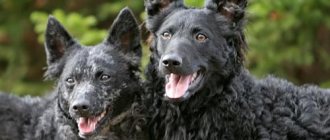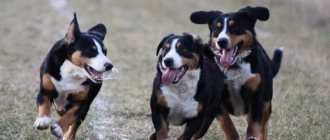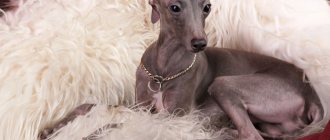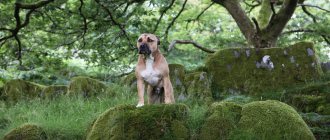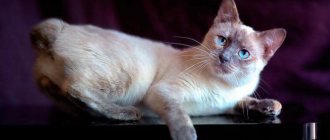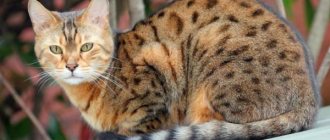Breed characteristics
| Short description | |
| Origin: | Hungary |
| Conditions of detention: | House, local area |
| Purpose: | Hunting dog, companion |
| Color: | Red-golden, red |
| Wool length: | Short, smooth coat or medium-length harsh coat |
| Adult dog size: | The height of the female is 54-60 cm, the male is 58-64; male weight – 25-27 kg, female – 20-25 kg |
| Average life expectancy: | 12-14 years old |
| Walk: | A long walk twice a day is required, even when kept on the street. |
| Physical activity needs: | High physical activity needs (hunting, jogging, swimming) |
| Fédération Cynologique Internationale (FIC) classification: | Group 7: cops; section: continental pointers |
| Puppy price: | From 42,000 rubles to 80,000 rubles. Pet class – up to 45,000 rubles, breed class – up to 60,000 rubles, show class – 70,000-80,000 rubles. |
Description of the breed
According to the FCI standard, the Hungarian Vizsla can be of two types: short-haired (No. 57) and wire-haired (No. 239) . FCI standard No. 57 dated September 13, 2000 “Rövidszőrű magyar vizsla”. FCI Standard No. 239 dated 13.09.2000 “Drotzörü Magyar Vizsla”. Group 7 "Cops". Section 1 “Continental Pointers”. The FCI standard specifies the height at the withers:
- males – 58 – 64 cm with a weight of 20-29 kg;
- females – 54 – 60 cm with a weight of 18-25 kg.
The standard describes the following exterior criteria.
Vizsla head:
- rounded with a not wide skull and not a pronounced groove;
- the muzzle is not sharp, with strong jaws and developed muscles;
- eyes of medium size, oval, brown and darker shades;
- the color of the nose matches the general color of the coat, but is somewhat darker;
- jaws with a scissor bite;
- the teeth are evenly spaced - the lower incisors overlap the upper ones without a gap;
- The ears are hanging, moderately long, V-shaped with a rounded tip.
Description of the Vizsla body:
- the back is strong and straight with well-developed muscles, flowing into a short loin;
- the croup is elongated and slightly inclined towards the base of the tail;
- the chest is not too wide, but with a moderately prominent anterior part;
- The elbow joints are located at the same level as the chest, the ribs are laid back.
The tail has a thin tip and a wide base. Usually the dog holds it straight or bent in the shape of a saber.
The limbs are slender, with strong bones and noticeably developed muscles. The paws are tightly knit, slightly rounded. The thighs are muscular and the lower legs are moderately thin but strong.
The wire-haired type of the Hungarian Pointer has a hard and thick coat with a water-repellent undercoat. On the limbs, lower chest and abdomen, the covering is shorter and thinner, as on the head and ears, but not soft to the touch. There is also a beard located on both sides of the muzzle, and it is more rigid. In the neck area the coat forms a V shape.
The short-haired type of Hungarian Vizsla has a short and dense coat that should be rough and hard to the touch, covering the entire body. No undercoat. On the head and ears the hair is thinner, softer and shorter. The hair on the bottom of the tail is slightly longer. The underbelly is covered with sparse hair.
The standard color ranges from reddish-golden to various shades of wheaten.
The ears may be darker than the rest of the coat, but must be of the same tone. Red, brownish, light yellow or lightened tones of color are undesirable. Lips and eyelids should match the color of your nose.
It is allowed to have one spot on the chest or neck, which must be white and no more than 5 cm in diameter.
Obvious disqualifying signs:
- head that does not meet the standard;
- malocclusion or misalignment of the jaw;
- spots on the nose;
- drooping lips or eyelids;
- atypical eye color (from yellow to light brown);
- white paws;
- atypical coat (silky, too long, soft, curly, etc.).
History of the origin of the species
Dogs appeared back in the 10th century, they came to the mainland along with the nomadic Magyars, who hunted for survival. Later, the nomads settled in the region where Hungary is now located, became townspeople, and later - aristocrats. Thus the Vizsla became a breed of nobility.
"Vizsla" means "to seek" in Hungarian.
The dogs were crossed with local pointers and gundogs, which resulted in a short, shiny coat and impeccable working qualities. The law prohibited exporting the Vizsla abroad, because the breed was considered the property of the country.
Official breeding of dogs began in the 20s of the 20th century, when dog handlers tried to save the Hungarian Pointer from extinction. The standard was awarded to the breed in 1936. And a little later, the wirehaired Hungarian Vizsla was created (by mixing with the German Wirehaired Pointer). But this breed is registered separately.
History of origin and distribution
This is one of the oldest European breeds, whose history goes back at least a thousand years. It appeared simultaneously with the Hungarians or Magyars themselves. From Hungarian “vizsla” is translated as “to find”, “to search”. In 896, the ancient Magyars captured the Middle Danube Lowland. It is believed that the Vizsla, Komondor, Puli and Kuvasz breeds appeared with them.
The first information is on the stones - images of leaders on falconry with dogs that are very similar in appearance to modern Hungarian cops. Life was not easy for the Magyar tribes in Europe. Meat was obtained mainly from falconry. The dog found the bird by smell and pointed out its location to the hunter, who released the falcon. The winged predator killed the prey and delivered it to the owner. This method was used before the advent of firearms.
It seems that the Magyars crossed their hounds with native breeds. There is no direct evidence, but the Vizsla is similar to representatives of other breeds of central Europe, in particular the Transylvanian hound. The breed was first mentioned in 1350. In publications published between 1342 and 1382. The Viennese chronicles, which describe the life of the Magyars, have a chapter on falconry, and there are images of dogs.
The breed is mentioned before the Turkish occupation in 1526. The Golden Pointer comes to the Magyar lands with the Turks. It is crossed with the Vizsla, thanks to which the breed receives a unique color. In the descriptions that have come to us since those times, color and hunting skill are almost always mentioned. In general, as a result, only representatives of the nobility had the right to breed this breed.
Unlike most dogs of that era, the Vizsla was highly valued and allowed to sleep in the house. Although it was mainly used for hunting birds, it could also find hares and bears.
In the 17th century English and German hunting dogs appear in Hungary and quickly gain popularity. The demand for “natives” is falling, and the number of Vizslas is decreasing. By the end of the century, there are very few purebred dogs, and breeders begin to restore the breed. They most likely crossed the dogs with the German and English Pointer and possibly with the Irish Setter.
Due to the First World War, the population decreased significantly, but breeders came to the rescue here too. Since 1920, tail docking has become fashionable to avoid injury during hunting. In 1930, several breeders decided to breed a dog that would be better suited to hunting in damp climates, in the bush. They are crossed with the Vizsla Drahthaara to produce the Wirehaired Vizsla, which is considered a separate breed.
During World War II, Hungary was occupied first by German troops and then by the USSR. Because of the fighting, native breeds were practically destroyed. The decline in numbers was due to hunger and bombing; almost no dogs were bred. At the end of the fighting, several hundred Vizslas remained.
If not for American soldiers and Hungarian emigrants, the breed might have disappeared completely. Emigrating Hungarians took dogs with them and created kennels in countries where this breed was not known at all. Returning American soldiers also brought puppies. Popularity in the USA played a major role in the restoration of the breed. Most cynological organizations of the time required at least three generations to pass before the breed was recognized. Thus, most Vizsla stud books date from 1945 to 1950, although the breed is at least a thousand years old, and for 500 of those years it is considered purebred.
In 1960, more than 500 dogs were registered, spanning at least three generations, born in America. Since the dogs arrived in the United States, they have become the most versatile hunting dogs. In almost any conditions they can hunt any game. An intelligent, good-natured dog wins fans faster than any other breed. Vizslas work great and are very beautiful. The breed is becoming more and more popular in all countries. In 2010, it was ranked 41st among 167 breeds in terms of the number of dogs registered in the AKC.
Distinctive features
The Vizsla is a lean, medium-sized dog, reaching 54-64 cm at the withers and weighing up to 27 kg. The breed is characterized by a streamlined, dry body, long limbs, and a proud carriage of the head. We can say that the Cops look aristocratic.
- Head with a dry skull, moderately wide between the ears. Cheekbones and brow ridges are clearly visible.
- The muzzle is square with a straight bridge of the nose. The jaws are strong, have a scissor bite, and have a full set of teeth. The lips are slightly jagged.
- The nose is large and reddish brown.
- The eyes are small, almond-shaped, brown or dark in color.
- The ears are long, round, set low, and fit tightly to the head.
- The body is rectangular, dry, strong. The topline is slightly sloping. The croup is rounded. The neck is long, moderately thick. The belly is tucked in. The chest is of medium volume.
- The tail is long, thin, set low, saber-shaped.
- The limbs are straight, long, strong with well-developed muscles. Paws are rounded.
- The coat is double-layered and lies tightly to the skin.
- Color – red-golden, red-brown.
Photo of an adult dog
Photos of puppies
Features of character and behavior
The Hungarian Vizsla is not your typical hunting dog. The breed is friendly to others. The animal gets along well with all strangers, never gets into conflicts, and does not “quarrel” even with cats and small rodents. The cop loves children, will play with them, but is unlikely to protect them from an enemy, because for this dog there are no bad people.
The Vizsla is very active, tireless, and hardy . She is ready to hunt all day long without feeling overtired. Animals have well-developed intellect and instinct; from birth they have all the necessary skills for work (stand up, follow the scent).
Another feature of the Hungarian Pointer is its attachment to humans. A dog cannot live without its owner for even a minute. She constantly needs contact with her family.
Description and features
descriptions of the Vizslas appeared in the chronicles of Hungarian noble families . Turkish, Prussian, and Austrian hounds, pointers, and greyhounds came to Hungarian soil with soldiers and traders. They mixed with Aboriginal dogs and influenced their working qualities. In the 18th century, the breed actively developed and acquired an appearance similar to that of today.
In the 19th century, she took part in testing pointing dogs in the field. They began to produce purebred offspring at the beginning of the 20th century. It was only in 1936 that the Federation of Cynologists (FCI) officially recognized this breed.
In the photo there is a Hungarian Vizsla and a Weimaraner
The vizsla in the photo is often depicted next to the hunter. At the same time, she demonstrates an excellent exterior, adopting a stance characteristic of pointing dogs. Short hair and golden color emphasize muscle tension and readiness to react to human actions. The whole body is strong and muscular. The proportions are classic. The height at the withers and the length of the entire body are approximately the same. The cop's back is straight and his chest is wide.
By temperament, the Vizsla can be classified as sanguine. A cheerful disposition does not interfere with maintaining constant contact with the owner and strictly following commands. Under arms he behaves responsibly and knows how to restrain himself. Usually moves at a trot. When active, it switches to an energetic gallop.
Males are medium-sized dogs: at the withers they reach 60-65 centimeters and weigh 22-30 kilograms. Bitches are more graceful: at the withers they grow to 55-60 centimeters and weigh 18-25 kilograms. Otherwise, sexual differences are the same as in all canids. By character, males are more straightforward, females are more affectionate, but there are no significant differences.
The Hungarian Vizsla is recognized by dog handlers, breeders and ordinary owners as one of the most intelligent dog breeds. Her training begins at two to three months. At the age of six months, it is time to train the dog to hunt game.
Vizsla training
The dog learns new skills quickly and with pleasure. You can expand the range of her knowledge and skills almost throughout your life. The only thing a dog cannot stand is the rude and aggressive attitude of people. In addition, an adult dog has a hard time accepting a change of owner. In states where docking is allowed, the Vizsla's tail is shortened by a quarter of the length. In order to improve hunting qualities.
Advantages
Owners of Hungarian Coppers dote on their pets. How can you not love such loyal and intelligent animals? Breeders boldly declare the main advantages of the breed:
- Sociability, lack of aggression, friendliness to people and animals;
- Love for children;
- Mobility, energy;
- Balance, calmness;
- Sensitivity (the dog senses emotional fluctuations, knows when to approach the owner and when not to);
- Unobtrusiveness;
- Loving nature;
- Developed intelligence and quick learner.
Care and maintenance
The Vizsla is a fairly large dog, which is simply inconvenient to keep in an apartment. But Cop doesn’t care what conditions he lives in, the main thing is to be close to a person. After all, animals have worked side by side with people since ancient times.
It is better for the Hungarian Vizsla to be in a large country house with free access to the street . The breed is not suitable for chains or kennels. Keeping in a kennel is acceptable provided there is frequent contact with the family and the ability to enter the house at any time.
Such a pet does not require special conditions and careful care. But it needs frequent long walks and constant attention from household members. Before buying a dog, it is important to purchase a heated bed or kennel (you can build it yourself), height-adjustable bowls, toys, a collar and a leash.
Nutrition
Cops are not picky. They will eat what they are used to from puppyhood.
- Babies up to 1.5 months are fed by the mother, later complementary foods are introduced in the form of milk porridges.
- At 2-2.5 months it is already allowed to give grated boiled meat and baked apples.
- From 3 months it is possible to switch to baby dry food (must be softened with water or kefir before serving).
Ready-made food makes keeping a dog much easier. The products do not need to be boiled or diluted additionally, just determine the serving size. Moreover, high-quality food contains the necessary complex of vitamins and minerals, so there is no need to worry about balancing the diet.
Any super-premium class food for active breeds (or hunting breeds) of medium and large sizes is suitable. It is important that the composition does not contain dyes, preservatives, flavor enhancers, corn or wheat. Meat should come first (from 35%).
Dry food is convenient due to its variety. You can choose a product for puppies, pregnant females, sick and elderly dogs, and allergy sufferers.
Natural food is more difficult to prepare, but it is often cheaper than complex feed. It will not be possible to achieve a complete balance of microelements, so you will have to introduce vitamin supplements.
- A serving should consist of 40% meat: chicken, beef, turkey, rabbit.
- Other proteins will also work: kefir, cottage cheese, sea fish, eggs.
- Carbohydrates – buckwheat, oatmeal and rice, cooked in water.
- Fats – fish, including Omega-3, and vegetable oils (linseed or olive).
- It is useful to add raw or boiled vegetables (carrots, beets) and fruits (apple, pear).
The serving size depends on the age and weight of the dog. Up to a year, puppies are fed 3-5 times, 200-250 grams. Adult pets – 2 times a day, 400-600 grams.
Prohibited foods include bones, potatoes, flour and confectionery products, onions and garlic, tea, alcohol, fatty, fried, butter and pork. It is not recommended to give milk to dogs older than 3 months.
We recommend that you read a detailed article on the topic: “How and what to feed a dog: types and characteristics of nutrition.”
Health
The Hungarian Vizsla can be called a strong dog. With its rather large size, the Pointer lives up to 1 2-13 years , and with proper care - up to 15-16 . The main thing is to follow the training regime, feed your pet properly, take it to the veterinary clinic for examinations every 5-6 months and get vaccinations according to age.
Vaccinations
Hunting breeds need timely vaccination more than others. Instinct guides even an untrained dog. Vizslas often bring killed game found in the plantings or bushes near the house.
Contact with wild animals and birds increases the risk of infection with dangerous viruses that the immune system cannot cope with.
- The club that sells the puppies is responsible for the first vaccination But private breeders rarely vaccinate newborns, so it is better for the owner to find out whether the procedure was carried out.
- According to the schedule, the first injection should be given at 2.5 months, when the puppy’s immunity ceases to be fueled by the mother’s immune cells obtained from breast milk. Inactive strains of parainfluenza, adenovirus, enteritis, hepatitis and distemper are introduced.
- After a couple of weeks, the procedure is repeated and strains of leptospirosis are added to the serum.
- At 7 months they are vaccinated against rabies, at 12 months all vaccinations done previously are repeated.
- Annual revaccination is required, the duration of the drugs is designed for 12-20 months . After this period, the strains cease to act and the dog’s immune system “loses its vigilance.”
Important article on the topic: “Everything you need to know about dog vaccinations.”
The above vaccinations are considered mandatory. Without them, the dog cannot be walked in public places, transported across the border, or knitted. There are also additional vaccinations against piroplasmosis and lichen. The owner can give them to the pet at will, for example, at a time of exacerbation of diseases in the region.
On the day of vaccination, the dog must be healthy. Therefore, 2 weeks before the procedure, cleansing of helminths and ectoparasites is carried out. Lethargic animals with fever and other symptoms are not allowed for vaccination.
Diseases
Breeders try to cull individuals with hereditary (congenital or manifest) diseases. However, genetic health problems occur in 40% of cops. The following diseases are most often diagnosed in the breed:
- Oncology;
- Hypothyroidism (thyroid dysfunction);
- Hip dysplasia;
- Glaucoma and cataracts;
- Retinal atrophy;
- Atopic dermatitis;
- Poor blood clotting (hemophilia);
- Von Willebrand's disease (as progressive hemophilia).
Walk
Walking is vital for the breed . Even if the dog lives outside in a kennel or enclosure and walks freely around the yard, it is imperative to take him outside a limited area (into the forest, planting, field, dog park).
You need to run a lot. An owner who is not a hunter can give the pet a chase after a mechanical hare. Cops like to chase a ball and go through an agility course. Such a four-legged friend will share any sports hobbies: swimming, cycling or rollerblading, tennis.
On average, an adult Hungarian Pointer requires 2 walks (morning and evening) for 2-3 hours. Puppies are walked 3-4 times a day for 40-80 minutes.
Grooming
These dogs require virtually no grooming. Their short coat is considered hypoallergenic, although they shed twice a year. Brush it once every 2 weeks with a glove brush. During the seasonal coat change period, it is better to wipe the dog with a fleecy cloth every 10 days.
are bathed once a month with gentle detergents. In the summer, dogs can and should be taken to natural bodies of water so that they can rinse off and swim to their heart's content. Be sure to wash your paws after every walk.
The breed has a weak spot – the ears. Due to the hanging position, the ear canal is not ventilated, moisture accumulates there, and pathogens multiply. You can prevent the development of otitis media if you inspect your pet’s ears daily and clean them of wax accumulations.
The nails of hunting breeds are rarely trimmed, but if the dog is kept in a house or apartment, the plates do not wear off by friction against the asphalt. Then you need to shorten them every month. Teeth are brushed every week. You can use traditional tools (a brush and dog toothpaste), rubber toys with bristles, or chewing sticks.
Features of maintenance and care
The Vizsla is primarily a hunter, but this does not mean that only people who share this hobby can have one. Recently, Vizslas are increasingly living in apartments as companion dogs. Most of them are quite satisfied with this role. Of course, subject to a very good walk. The coat is short and without undercoat, but this is not a solution to keeping hair out of the house. Short, coarse hair is scattered across the floor, digging into upholstered furniture and clothing. There will be virtually no odor from your dog if properly cared for.
The Vizsla is only suitable for hunters or active people.
It should be noted right away that she gets along well with children, but due to her mobility, she can accidentally push or bite a child while playing. The dog will protect its family when necessary, and the fact that the Vizsla was bred to work for long periods of time makes it an ideal partner for long walks or runs. On the street, the Hungarian Vizsla cannot contain its hunting passion and will constantly catch pigeons, track hedgehogs or chase cats.
Care
Simple dog care is one of the reasons why people often choose the Hungarian Vizsla as a companion. Smooth short hair needs to be brushed once a week. Bathed once every 3 months or as needed. In between, they usually wipe the coat with a damp towel or rinse the dog in the shower. Check and clean your ears regularly.
Diet
The Hungarian Vizsla eats little, is picky and very picky about the quality of food.
If this is natural food, then the dog may choose pieces of meat, but not touch the porridge. She looks at the treats from the master's table with eyes as if she hasn't been fed for a week. Ready-made karma should also be selected taking into account the dog’s taste preferences. There is no need to change the diet that meets the dog's needs unless necessary.
Mating
Hungarian Vizslas are rare hunting dogs for which it is important to preserve their working skills in their natural state, therefore all matings must be official, club, sealed by an agreement. To ensure a high-quality litter, breeders make pairs of opposite dogs that complement each other’s strengths and weaknesses.
Large dogs require the intervention of a professional in mating. It is not so easy to help them, because you need to keep the female and male in one position for 15-20 minutes while the “lock” lasts. Vizslas are quite heavy, so the strength of both owners and the dog handler will be needed.
Pets are untied at 2 years old, then the maturation stage is completed, dogs are able to conceive, bear and give birth to healthy offspring. The female is brought to the territory of the male; you can walk the animals in advance and introduce them. On average, the act lasts 20-30 minutes.
Read a detailed article on the topic: “Everything you need to know about breeding dogs: appropriate age, what to do if it doesn’t work out, rules and tips.”
Key points in training
The Hungarian Vizsla is a highly intelligent dog, it learns quickly and does not strive for leadership in tandem with its owner. The cop is obedient, especially if raised from childhood . It’s easy to get her interested in play training. It is better to motivate the Vizsla with toys; goodies are also suitable, but balls, rings and other attributes will be a real joy for the dog.
It is not necessary to train the Cop to hunt; she has innate skills in finding and catching game. But special training will further reveal the animal’s potential.
The Vizsla puppy is kept indoors for up to 3 months. At this time, you can give your baby all the basic rules of behavior. The dog must know the feeding and walking schedule and follow the regime. The pet needs to learn its name, basic commands (“sit”, “lie down”, “no”, “place”, “next to me”, “to me”).
Read about how to properly train a dog in the article: “Training a puppy: effective methods from dog handlers, learning commands at home.”
Hunting Abilities
The Hungarian Vizsla is created for hunting, during which it becomes serious, organized, and purposeful. Dogs of this breed are distinguished by excellent hearing, sense of smell, agility, speed, and the ability to navigate the terrain well, so they are good for hunting both animals and birds. It is no coincidence that the word vizsla means “to seek” in Hungarian. The goal of a cop on a hunt is to find the desired prey and then deliver it to the owner.
Of course, such abilities must be taught to the dog from childhood. Dog handlers recommend taking the Hungarian Vizsla out into the wild as a six-month-old puppy so that it can try to hunt. Otherwise, the animal will have poor orientation on the terrain and will lose its natural abilities. Since Vizslas are energetic by nature, they are suitable for people who do not like to sit idly in one place, but prefer hunting, walking and traveling.
Where to buy a puppy: nurseries
The main feature of Hungarian Vizsla puppies is a sad, folded muzzle, decorated with long ears, disproportionately large in relation to the head. The proportions of the body are preserved - long body, thick paws, strong neck. The color of the Pointer does not change with age, but may darken slightly.
When choosing a puppy, it is important to pay attention to possible congenital pathologies or changes in appearance that deviate from the standard. It is better to purchase a baby from nurseries or breed clubs. Although the Hungarian Pointer is not particularly popular, you can find an official breeder in Russia:
- Moscow "Tina Trading";
- Stavropol "ALEKSTIANA";
- Yaroslavl “Beauty of Fire”;
- St. Petersburg "Lembo Prout".
Reproduction and lifespan
There are cynological nurseries whose main task is to produce puppies of pure blood. Private owners of purebred dogs provide their pupils with the opportunity to prolong their breeding.
Several methods of purebred crossing are used:
- Outbreeding. In this case, dogs that do not have common ancestors are selected for crossing.
- Inbreeding. Dog relatives participate in crossbreeding.
- Linebreeding. Offspring are obtained from dogs that have a distant common ancestor.
- Outcrossing - this method is similar to linebreeding, but dogs in 4-5 generations do not have common ancestors.
Inbreeding gives the most predictable results with the consolidation of properties characteristic of the breed. This method is accompanied by careful culling of puppies to avoid degeneration of the breed. To reproduce the breed, dogs undergo a special test at the age of two. It is organized and conducted by judges from the canine association.
Hungarian Vizsla puppies
In any case, not only dogs are involved in the continuation of the Hungarian Vizsla family. The process is prepared and organized by owners (breeders) and representatives of official canine organizations. Such a difficult path makes it possible to obtain high-quality puppies that will grow into excellent hunters and will delight the owner with their company for at least 15 years.
Owner reviews
The breed does not cause negative feedback from owners, breeders or uninterested people. Vizslas are not aggressive, but intelligent. Suitable for family life and hermit hunters.
- Drew : “Great dog, kind, affectionate, smart and loyal. This is a good hunter, even without special training, the Pointer will stand up and bring game. A loving pet, she adores everyone who approaches her, very playful. The downside is that walking is difficult. Such a dog requires constant movement, sometimes there is simply no strength to go outside for 3 hours, but without such a walk the Vizsla will “wither”.
- Diana : “This is not a couch dog. The Hungarian Vizsla is an expensive, rare breed, and there is no point in owning one for the amusement of children or for personal joy if the family is not ready for constant walking, training, and hunting trips. Cops are the smartest animals, kind and sweet. But they are very closely connected with the owner, do not tolerate separation, and require a lot of attention and care.”
- Igor : “An excellent hunting dog, I trained it myself as best I could. He follows the trail and reacts instantly to the gun. A good smart pet, a close friend, fun for children. The Vizsla gets along well with the whole family, but only recognizes one leader, which suits me.”
Breeding and maintaining a hunting breed is always a big responsibility. Such pets are large, often get sick, and require training, constant training and walking. But, despite the long list of rules for care and education, those who are not afraid to get a Hungarian Pointer will be very lucky with their four-legged friend. After all, they will receive a forever devoted huge heart full of love.
We have written many times that Hungarian Vizslas are extremely capable and versatile dogs for any type of activity. If the owner is not interested in hunting, then there are many different sports and types of activities where the Vizsla can prove itself.
— Agility is a competition in which the owner guides the dog through an obstacle course. When passing, speed and accuracy are taken into account. The owner has no right to touch the dog or obstacles, with the exception of accidental touches. You can control your dog with your voice, gestures and various body signals. Both young and adult dogs are allowed to participate in agility training.
— Coursing is running after a mechanical hare. This sport is intended for hunting dogs, but all breeds actively participate in it. At such competitions, the speed, agility, and endurance of the pet are assessed.
— Freestyle – dancing with a dog. The most creative sport, it is a combination of obedience exercises and various tricks performed by a dog and a person to the music. Dancing with dogs takes place in the form of competitions. First of all, the dance should demonstrate the dog's abilities and skills, as well as the interaction between the dog and the owner.
— Flyball – its essence consists in the dog overcoming an obstacle course to a special mechanism (flybox), catching a ball flying out of it, and returning through the same barriers to the owner. The special feature is that the dog must independently press the flybox pedal to receive the ball.
— Frisbee dog — this sport combines elements of play and acrobatics. Its essence is not only for the dog to catch a disc (Frisbee) thrown by the owner, but to do it as effectively and beautifully as possible.
— Cani-cross is running in conjunction with a dog through a special shock-absorbing leash - a tug. Distances can be different, from four hundred meters to five kilometers. The dog should run in front and the person behind. It is forbidden to hold the leash with your hands and move the dog. As good sprinters, Vizslas are excellent for this sport.
— Skryjoring is a winter type of canicross where a person moves on skis. These competitions are also held for speed; the physical fitness of the athlete and the dog is assessed.
— Bikejoring is a type of screejoring, but it takes place in the summer and involves an athlete on a bicycle.
It is important to remember (!): any sports activity should be preceded by a warm-up, and then a cool-down. A dog involved in a particular sport must exercise regularly. She must be healthy and not injured.
In addition to active sports with a Vizsla, you can also engage in canine standards, such as OKD (general training course) and UGS (controlled city dog). Passing these standards will make your life together with your dog more comfortable and convenient. Another discipline of canine sports is obedience - dog obedience competitions, popular all over the world. It is also not only interesting as a type of training, but also useful in everyday life.
Vizslas are also well suited for the role of search dogs. To develop this incarnation of them, one can and should engage in SSS (search and rescue service), mentrailing - searching by scent trail, or blood trail, which is also used for testing.
Owner, remember (!): an active and eventful life for a dog is the key to its long and happy life. A Vizsla that has some kind of occupation is much more comfortable in everyday life, it does not create problems, and does not have destructive behavior.

